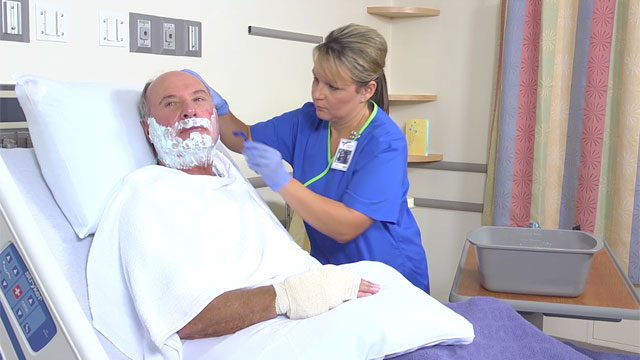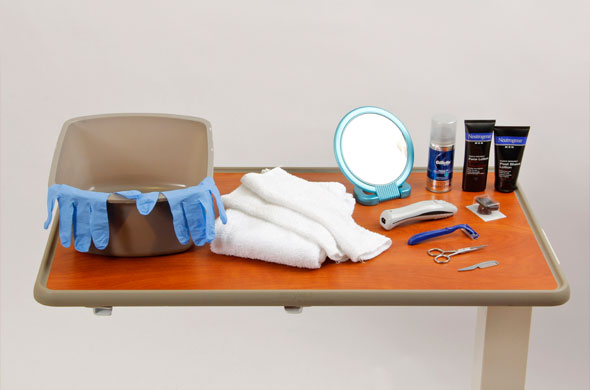Personal Hygiene and Grooming
Select a Skill:
- » Performing Oral Hygiene for an Unconscious Patient
- » Cleaning Dentures
- » Performing Hair Care and Shampooing in Bed
- » Shaving a Male Patient
- » Performing Nail and Foot Care
- » Assisting with a Gown Change
Take the Review Test:

Safety
- Always assess the environment for safety before administering hygiene care to a patient. Check the floor for spills, and make sure equipment is working properly. When not performing procedures, the patient’s bed should be in the locked, low position with at least two, but no more than three, side rails raised.
- Observe Standard Precautions when providing care, which includes wearing clean gloves. Additional precautions requiring other personal protective equipment (PPE) may be necessary, depending on the patient’s condition.
- Be sure the call light is easily accessible to the patient at all times.
- Monitor patients who have a decrease in sensory perception, such as those with peripheral neuropathy.
- Before shaving, review the patient’s medical history, medications, and laboratory values, such as platelet count and anticoagulation studies.
Equipment
(Roll cursor over items to see labels)

Electric razor
Disposable razor
Spare razors
Scissors
Moustache comb (optional)
Bath towels & washcloth
Washbasin
Shaving cream
Aftershave lotion
Skin or beard conditioner (optional)
Hand mirror
Clean gloves
Delegation
The skill of shaving a male patient can be delegated to nursing assistive personnel (NAP). Be sure to inform NAP of the following:
- A male patient should not be shaved with a disposable razor if he has a bleeding tendency
- A male patient should be encouraged to use his own electric razor from home unless doing so is contraindicated
- Report how the patient tolerated the procedure and any concerns
Preparation
- Assess the environment for safety, such as checking the room for spills, making sure that all equipment is working properly, and ensuring that the bed is in the locked, low position.
- Assess the patient’s shaving product preferences, such as aftershave lotion or skin conditioner.
- Before shaving, determine whether the patient has a bleeding tendency. Review the patient’s medical history, medications, and laboratory values, such as platelet count and anticoagulation studies.
- Assess the patient’s ability to manipulate a razor.
- Ask the patient to explain during the procedure the steps he uses to shave. Ask the patient to indicate if he becomes uncomfortable.
- Position the patient sitting in a chair or in the bed with the head of the bed elevated to 45 to 90 degrees, as tolerated.
Follow-up
- Inspect the condition of the shaved area and the skin underneath the beard or moustache.
- Ask the patient if his face feels clean and comfortable.
- Ask the patient if he is satisfied with his degree of participation.
Documentation
- Record the shaving procedure. If there is no area indicated for shaving, make a nurse’s note in the medical record. Note how the patient tolerated the procedure and if there were any complications, such as bleeding, pain, or problem skin areas.
Review Questions
1. When preparing to help a male patient shave, why does the nurse first review the patient’s medical history?
 To determine the patient’s risk of bleeding
To determine the patient’s risk of bleeding  To see how often he prefers to shave
To see how often he prefers to shave  To learn which is his dominant hand
To learn which is his dominant hand  To determine whether he can perform the task himself
To determine whether he can perform the task himself
2. Why would the nurse encourage a male patient to use an electric razor for shaving?
 To reduce the use of hospital supplies
To reduce the use of hospital supplies To reduce the risk of infection
To reduce the risk of infection  To reduce the risk of bleeding from a disposable razor
To reduce the risk of bleeding from a disposable razor  To encourage him to shave himself
To encourage him to shave himself
3. Which action is most important in minimizing the patient's risk for injury when preparing to shave a patient with a history of bleeding?
 Fully explain the process to the patient in order to secure his cooperation.
Fully explain the process to the patient in order to secure his cooperation. Pay particular attention to technique in order to avoid nicks and cuts.
Pay particular attention to technique in order to avoid nicks and cuts. Ensure that the provider has ordered the intervention.
Ensure that the provider has ordered the intervention. Review current platelet count and anticoagulation studies.
Review current platelet count and anticoagulation studies.
4. Why would the nurse instruct nursing assistive personnel (NAP) to hand the patient a mirror before trimming his moustache and beard?
 To distract him so that he will stay still
To distract him so that he will stay still  To allow him to point out which areas he would like to have trimmed
To allow him to point out which areas he would like to have trimmed  To promote his sense of independence
To promote his sense of independence To keep his hands away from his face
To keep his hands away from his face
5. What is the best way for the nurse to ensure that the patient is comfortable while he is being shaved?
 Administer a prescribed analgesic 30 minutes before beginning the procedure.
Administer a prescribed analgesic 30 minutes before beginning the procedure. Gently pull the skin taut in order to avoid nicks and cuts.
Gently pull the skin taut in order to avoid nicks and cuts. Ask the patient if he is comfortable several times during the procedure.
Ask the patient if he is comfortable several times during the procedure. Encourage the patient to shave himself if he is capable of doing so.
Encourage the patient to shave himself if he is capable of doing so.
You have completed the Review Questions for this skill. To take the Review again select the Start Over button. To proceed to another skill select from the dropdown menu. Select the Home or Back button to proceed to the next section.


